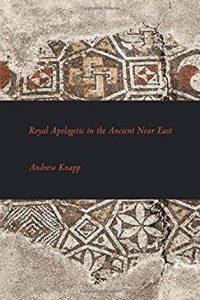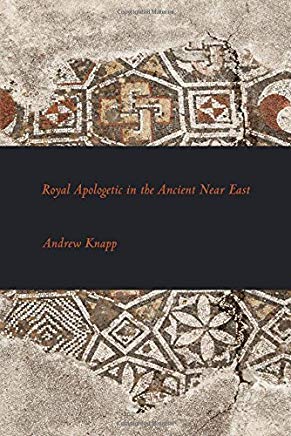Knapp, Andrew. Royal Apologetic in the Ancient Near East. Atlanta, GA: SBL Press, 2015, pp. 419, $59.95, paperback.
Andrew Knapp’s work Royal Apologetic in the Ancient Near East, grew out of his 2012 Johns Hopkins dissertation. Knapp currently serves as development editor at William B. Eerdmans Publishing Company. Knapp’s primary goal is to determine how apologetic functioned in the ancient Near Eastern (ANE) royal literature, then to analyze texts he understands as exhibiting traits of “royal apologies.” The work is organized into 10 chapters. Chapters 1–2 define royal apologetic in the ANE and presents a methodology for analyzing these texts. Chapters 3–9 analyze various ANE royal texts in light of the work in chapters 1–2. Chapter 10 serves as a conclusion summarizing the information gleaned from the seven texts analyzed in the work.
Knapp begins his work by defining apologetic literature based on rhetorical studies of apologetic material. He demonstrates that the field of ANE studies tends to define apologetic literature as a literary genre based on a definition of apology borrowed from Greek classical studies. Knapp argues that ANE apologetic is a literary mode rather than a literary genre (pp. 31–42). Based on his evaluation of apologetic as a literary mode rather than genre, apology in ANE royal material must be evaluated based on the propagandist claims inherent to each document; no overarching literary rules are can be expected for ANE royal apology.
After defining ANE apologetic as a mode, Knapp examines the way ANE royal literature uses apologetic motifs. He identifies ten motifs found in ANE apologetic material but focuses on the motifs of divine election, royal prerogative/affiliation, and popular acclamation. Knapp refers to these three motifs as the “triad of legitimacy” for ANE kings (p. 46). With the motifs common to ANE apologetic in mind, Knapp demonstrates that there are apologetic elements to multiple ANE royal texts spanning several genres.
From the texts he identifies as examples of royal apologetic Knapp selects seven for analysis in his study: The Proclamation of Telipinu, The Autobiography of Hattusili III, The Tradition of David’s Rise and Reign, The Succession Narrative of Solomon, The Tel Dan Inscription of Hazael, The Accession of Esarhaddon, and The Rise of Nabonidus. In each of these documents, Knapp explores the circumstances of ascension for the king in question, discusses the text and provides a translation of each non-biblical document, and examines the Sitz im Leben of each document. The telos of his approach is to offer a “the first systematic treatment of apologetic in the ancient Near East” (p. 73).
Among the ANE documents Knapp analyzes, The Traditions of David’s Rise and Reign and The Succession Narrative of Solomon are unique. Both the biblical texts included in the study are reconstructed from sources within the biblical text. All of the other texts in the work are royal inscriptions with the exception of The Proclamation of Telipinu, of which Knapp claims “there is no reason to question whether Telipinu himself commissioned the text” (p. 110).
In his discussion of David’s Rise and Reign and The Succession Narrative of Solomon, Knapp uses source criticism to determine the “authentic” material “within the disparate biblical record” (pp. 167–68). Knapp departs from works of previous source critics who sought to isolate each individual source within the biblical narrative. Instead, Knapp attempts to isolate the early Davidic narratives from those added to the biblical text after David’s reign (pp. 168–69). The source-critical analysis of David’s Rise and Reign results in a set of forty-seven individual narratives that contain sources contemporary to the reign of David. Knapp’s analysis of The Succession Narrative of Solomon follows a similar pattern. In both cases, the result of Knapp’s source-critical analysis yields more “authentic” narratives than usually proposed by source critics.
Knapp’s study of ANE royal literature offers a new way of understanding apologetic within those texts. Against the common notion in the field of ANE studies that royal apologetic is a culturally bound genre, Knapp demonstrates that “defense against accusation is not culturally bound, but common to all human society” (p. 360). Apologetic features of ANE royal literature, therefore, is not a genre but is instead a mode of writing necessitated by the social/political issues facing the king.
Royal Apologetic in the Ancient Near East should shift how biblical and ANE scholars understand royal apologetic literature. Knapp offers readers a way to understand apologetic texts based on the concerns of ANE royal life and literature. By encouraging readers to understand apologetic based on rhetorical concerns rather than on conformity to a literary genre, Knapp offers readers of ANE royal texts a better way to identify and interact with apologetic material.
The greatest value of Royal Apologetic in the Ancient Near East for biblical scholars is the fresh approach to understanding apologetic concerns in the narratives recounting the reigns of the kings of Israel and Judah. Knapp’s work focuses only on the reigns of David and Solomon, but he also identifies narratives from the reigns of Jehu and Joash as apologetic in mode (pp. 58–59). The motifs he identifies as central to the apologetic mode of writing are likely present in other biblical narratives as well. Other scholars may find value in exploring other royal narratives in the biblical text, as well as passages infused with royal language such as the Enthronement Psalms, to see if these texts use any of the apologetic motifs Knapp identifies.
Knapp’s use of source-criticism in the current work illustrates a difference in the way many scholars treat the biblical text versus other ANE sources. Knapp considers The Proclamation of Telipinu, as an authentic representation of Telipinu’s proclamation to justify his ascension to the Hittite throne (pp. 116–17). He offers no source-critical analysis of the text, even though the extant manuscripts date hundreds of years after the reign of Telipinu. Knapp’s decision to accept The Proclamation of Telipinu as a unified source but to parse the biblical texts for “authentic” historical material is not one that he explains within the work. Though his source-critical analysis of the biblical text represents a more inclusive model of “authentic” material than the analyses of many other source critics, the work would benefit from an explanation of why a source-critical analysis is necessary for the biblical documents, yet not from other ANE texts.
Overall, Knapp’s work is of tremendous value to students of the biblical text. His methodology encourages scholars in the field to revise their understanding of the function of royal apology in the ANE. Knapp also demonstrates that relying on definitions genre from other fields of study is not always helpful in understanding individual texts. Royal Apologetic in the Ancient Near East presents a challenge to biblical scholars to apply Knapp’s insight into the apologetic concerns of the ANE into their interpretation of biblical texts containing apologetic motifs.
Cory R. Barnes,
Shorter University





